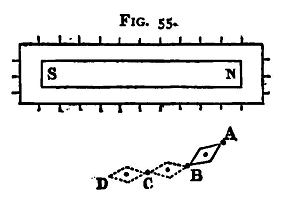| Practical Physics is a free textbook on basic laboratory physics. See the editorial for more information.... |

|

Home  Magnetism Magnetism  Exploration of a Magnetic Field Exploration of a Magnetic Field |
|||||






|
|||||
Exploration of a Magnetic Field
Place a bar magnet on a large sheet of paper on a table. In the neighbourhood of the magnet there will be a field of magnetic force due to the joint action of the earth and the bar magnet, and if a small compass needle be placed with its centre at any point of the field, the direction of the needle, when in equilibrium, will indicate, very approximately indeed, the direction of the line of magnetic force which passes through its centre. Draw a line on the paper round the bar magnet at a distance of 2 or 3 cm. from it, and mark off points along this line at intervals of 2 cm. Take a small compass needle and lay it so that its centre is above the first of the points so marked; it will then set itself in the direction tangential to the line of force which passes through the point. Make marks gn the paper exactly opposite to the points at which the ends of the compass rest, and as close to them as possible. Let AB (fig. 55) be the ends of the compass.
Move the compass on in the direction in which it points, and place it so that the end A comes exactly opposite the mark against the old position of B, while the end B moves on to position C, so that BC is the new position of the compass. Make a mark opposite the point C in its new position. Again move the compass on until the end at B comes into the position C, and so on. A series of points will thus be drawn on the paper, and a line which joins them all will very nearly coincide with a line of force due to the given distribution. The line of force can thus be traced until it either cuts the line drawn round the magnet or goes off the paper. Repeat the operations, starting from the second of the points on the line drawn round the bar magnet, and then from the third, and so on, until the lines of force for all the points are drawn, thus giving a complete map of the directions of the lines of force due to the combination.(1) Experiment. - Draw a map of the directions of the lines of force due to the combined action of the earth and the given bar magnet.
|
|||||
Home  Magnetism Magnetism  Exploration of a Magnetic Field Exploration of a Magnetic Field |
|||||
Last Update: 2011-03-19


